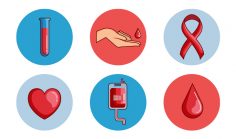Many people with diabetes live happy, healthy lives.
In order to keep your symptoms in check and your blood glucose levels within range, follow these tips:
- Monitor your insulin carefully. Don’t attempt to make adjustments without your doctor’s oversight.
- Maintain a healthy weight. Excess body fat causes cells to become resistant to insulin.
- Eat small, frequent meals to keep blood sugar in a healthy range. Eating large meals can flood the bloodstream with glucose.
- Keep refined starches and sugars to a minimum, choosing foods with a low glycemic index. Examples of “good” carbohydrates include sweet potatoes, winter squash and beans.
- Eat fish several times a week, emphasizing wild, cold-water fish high in omega-3 fatty acids, such as Alaskan salmon and sardines. Or take molecularly distilled omega-3 supplements.
- Increase your activity level. Aerobic activity improves insulin sensitivity in muscle cells, which allows more glucose to enter the cells. Aim for 30 minutes a day.
- Keep up-to-date with the latest advances in the treatment of diabetes.
- Connect with others who are also dealing with the disease, either with support groups in your community or online.
- Check your blood glucose regularly.
- Take your medication as prescribed.
- Get help for depression. Depression and diabetes are linked. A recent study in the Annals of Family Medicine found that treating both conditions helped people stay on top of their diabetes medications and led to improved blood sugar levels, as well as reducing depression symptoms.
- Inspect your feet daily. If you find a sore that isn’t healing, speak with your doctor immediately.
- Identify yourself. Wear a medical alert bracelet or, at the very least, carry an identification card that tells people you have type 2 diabetes to help health professionals treat you in case of emergency.
HEALTHY EATING
There’s no juvenile or type 1 diabetes diet – contrary to popular thinking. Your child will need plenty of fruits, vegetables, and whole grains – foods high in nutrition, and low in both fat and calories. Your child’s nutritionist will likely recommend that your child – along with the rest of the family – make the conscious choice to consume fewer animal products and refined sweets. While sugary foods are OK every once in a while, they should be limited, and budgeted into your child’s meal plan, particularly for special occasions. A registered dietitian can be a great member of your team – advising on everything from what foods are best for your child, how much, recipes and food sources, lifestyle and more. There are some places in which greater vigilance is needed; particularly with foods that have high fat content – because fat slows digestion, and foods with high sugar content as they affect insulin directly. Each individual processes food differently, with your nutritionist you can build a plan that works best for you and your child.
EXERCISE
While everyone needs regular exercise, children with type 1 diabetes are no exception – but remember that physical activity often lowers blood sugar, sometimes affecting levels for up to 12 hours after exercise. Check your child’s blood sugar more often than usual after more vigorous exercise or starting a new activity to learn how his or her body reacts. You may need to adjust your child’s meal plan or insulin dose to compensate. Do encourage your child to do all sports that kids non-type-1 dis do – anything from ballet to basketball to swimming. If it’s fun, they’re more likely to participate! Incorporate movement and physical activity into part of your child’s daily routine.
BUILDING FELXIBILITY INTO YOUR PLAN
Even with a careful insulin schedule, sugar levels in your child’s blood can vary unpredictably at times. With help from your child’s diabetes treatment team, you’ll learn what might trigger blood sugar level changes so that you can be prepared. Here are some possible triggers to be mindful of:
- Food – How much – and what – your child eats are they two key things that have the greatest impact on your child’s blood sugar levels. This can prove challenging for parents of very young kids with juvenile diabetes, as young children don’t always finish their meals. This can be an issue if you’ve given an insulin injection to cover a larger meal than was consumed. Speak to your diabetes team if this becomes a recurring issue.
- Exercise – Engaging in physical activity moves sugar from the bloodstream into the cells – and the more active your child is, the lower his or her blood sugar levels will be. You may need to lower your child’s insulin does prior to vigorous physical activity to compensate, or perhaps your child might have a pre-exercise snack to help keep levels more steady.
- Illness – If your child has a fever, it will increase metabolism – which affects insulin dose needed. Similarly, with a cold or other illness, hormonal fluctuations can increase blood sugar levels. Therefore during any type of illness, insulin doses need to be more carefully calibrated, and perhaps adjusted.
- Medication – Insulin is critical for a child with type 1 diabetes to maintain steady blood sugar levels, but other types of medication may affect blood sugar levels as well – which may require changes to your child’s diabetes treatment plan.
- Puberty and growth spurts – This hews to the adage that change is the only constant; as your child grows, especially during times of growth spurts, he or she may not be getting enough insulin. Hormones come into play when your child enters puberty, affecting insulin requirements – especially for teenage girls when they begin to menstruate.
- Sleep – For most children, blood sugar levels dip during the night, which is why blood sugar levels tend to be slightly higher before bed than they are in the morning. Monitoring the range of normal is a good rule of thumb to make sure your child is doing well:
- Children younger than 6: pre-bedtime levels from 110 to 200 mg/dL
- Children between 6 and 12: pre-bedtime levels from 100 to 180 mg/dL
- Teenagers and adolescents: pre-bedtime levels from 90 to 150 mg/dL













